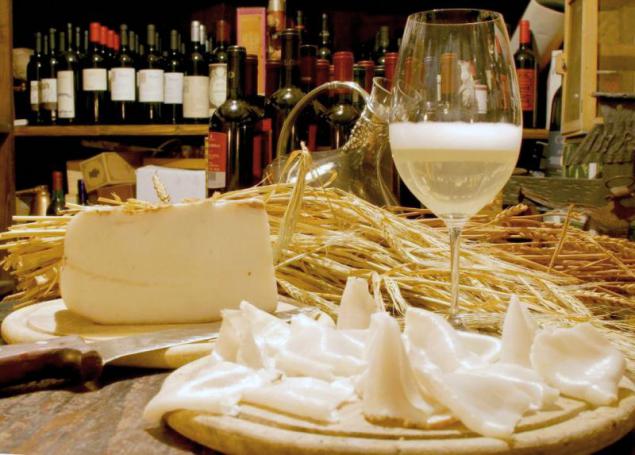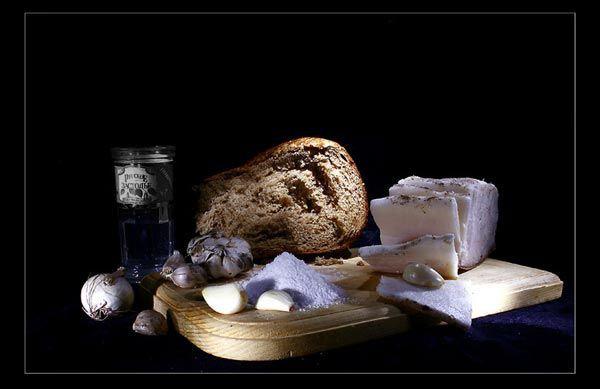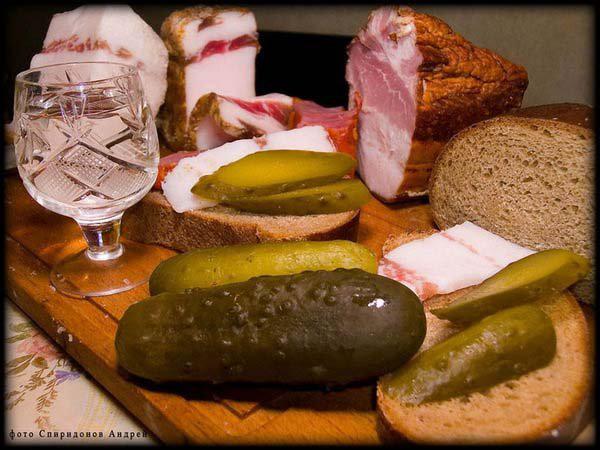History fat
 Bashny.Net
Bashny.Net
Salo has always been staple food of the poor, for the best cuts of pork carcass battered, those who could pay for them or take away. So the poor have learned to procure fat for future use by pickling, sometimes smoked, and further aging. Virtually every nation will claim that their fat - the best in the world. Russian and Ukrainian, will be for its "fat", the Belarusians for their "fat", German for "peg" for the Balkan Slavs "Slanina" Poles for "sloninu" Americans for "fetbek", etc. But if anyone ever tried «Lardo di Colonnata» or «Valle dAosta Lardo dArnad» hardly dare to challenge the superiority of the latter two.
6 ph + letter via moole.ru

«Lardo di Colonnata» comes from the small mountain town, if not the village Colonnata, located next to the famous Carrara marble developments that in the Apuan Alps of northern Tuscany. Local men are mostly employed in the quarries traditionally took with them on Lardo snack, eating together with other typical Italian food - bread, olives and tomatoes. Currently Lardo ceased to be a food of the poor, and has become a local landmark, even eclipsed the glory of Carrara marble. Yes, Colonnata owes its existence marble, and his fame - fat. A small amount, almost clandestine production (because of the constant "raids" of the local sanitary inspection) is unable to meet the growing demand for this product, and that the market has already appeared fake, which have the same relation to the real thing as Borzhom Manufactured in Yessentuki to his Georgian counterpart.
Lardo - the product is very ancient. Even Emperor Justinian legally obliged to supply the army Lardo to legionnaires had enough energy in campaigns and battles.
The originality of the cooking process Lardo is based primarily on the use of troughs carved out of the local Carrara marble. As is well known sculptors very thorough approach to the choice of the stone, and if you find any flaw, they will refuse to from him. In order not to waste good, the local decided to use discarded marble blocks, hollowing of them a bath or trough for salting and aging lard. Marble has unique properties for food storage. It provides the necessary temperature and humidity, and is a natural "preservative", as the use of modern preservatives in Colonnata prohibited.
When cooking using fat from pigs that come from Parma and San Daniele, famous for its ham. Pigs must be at least 9 months and weigh at least 160 kg. Manufacturers currently taking his ham and bacon are sent to Colonnata.

Production of fat begins in September, with a thorough cleaning of marble tub with vinegar. Then, the inner surface liberally rubbed with garlic, in blocks of fat rubbed sea salt, which is washed away after. The bottom of the tub sprinkled with fresh salt and fat blocks are stacked, richly flavored with a mixture of herbs and spices. Each manufacturer has its own blend, and tries to keep it a secret.
But are mandatory black pepper, garlic, rosemary, nutmeg. Advanced - star anise, thyme, allspice, sage, oregano, coriander - well almost all known spices. The different proportions and combinations of spices enable each producer to have its "brand" family recipe and a variety of aromas and flavors. When the tank is full - it is firmly closed and the fat goes on aging.
Someone refers to the capacity of the wine cellar, someone in the local marble caves and cave for up to six months or until the spring. The result is a tender, melting in the mouth, enveloping its rich aroma fat, compared to which all other varieties fade and grow dim.
Italians can be proud of and other varieties of fat - from the Commune dArnad (Valle dAosta Lard dArnad) in the north-west of Italy, where the principle of cooking is almost the same as in Colonnata, but instead of the marble vessels used wood - oak, walnut or chestnut. Apparently, the original flavor of the bacon influence tannins and tannins contained in the wood. So it will be in Italy - especially Tuscany, try to try these delicacies - which turned from food legionaries and kamenolomschikov in the world hit.

However, back to the past. The Romans called fat "lard" in our time there is such a word, but it refers to is not fat, but what is otherwise called lard.
Less than a thousand years, as fat and recognized in Spain. Jamon - in Spanish - ham, ham. Hamon is essentially free of cholesterol and ever since remained a favorite meat product in Spain. It is believed that Columbus was able to get to America, thanks to the fact that among the supplies he had a lot of hams and bacon, which can be stored up to six months, it contains a lot of calories, and those calories long-lasting - the strength and energy of the poevshego fat (in moderation!) Restored for a long time , calorie product is 770 kcal per 100 g
And then one fish sailors would have had brutalized very soon ... So fat made their invaluable contribution to the history of the world - it is not opened to Columbus America, and there would have tomato and without tomato is cooked borsch and no borscht - What's this general culture ?!

People of the Middle Ages were eating bacon in large quantities. Sam St. Benedict, the founder of the Benedictine monks allowed to have fat. The monks said that "fat pig as related to each other as the vine and the wine." Salo is not only ate - in the Middle Ages also made of a candle. They do not really smelled, smoked, but the light is still allowed. Only it was necessary to watch, that tallow candles rats are not eaten, they'll also not stupid. Candle monks copied books - as in the darkness of the Middle Ages fat helped keep the light of the culture and transfer it to us.
This is a medieval text, translated by Guy de Val:
"After the monks cook washed his hands and face and read the three prescribed prayers, they wash the beans in three waters and then put them to cook on the fire in the boiler water. Then they shift to another pot with a tight-fitting lid. The beans seasoned with bacon. Salo did not need to add in the process of cooking vegetables, and in the end ... ". "Romance of the Fox": "At home, he had abundant and fat capons, and pickles and ham, and bacon. All this stuff defended a strong palisade of oak stakes and thorns ... »
A famous English bacon and eggs? bacon - is that you? It is the same. The English - the common people, considered and scientist, and take care of your health is good. After breakfast so helpful and pleasant, the British conquered the sea, developing capitalism, invented the steam engine and discovered the theory of evolution. So boldly waving your arms in the myths about the dangers of fat in our cold climate, it is in reasonable quantities is absolutely necessary. I'm not going to say that at this fire-breathing red borsch necessarily need cracklings, otherwise it is not soup and borscht diet layout, which gives this splendid dish purely visual representation.

So, eat the fat and be healthy!

Source:
6 ph + letter via moole.ru

«Lardo di Colonnata» comes from the small mountain town, if not the village Colonnata, located next to the famous Carrara marble developments that in the Apuan Alps of northern Tuscany. Local men are mostly employed in the quarries traditionally took with them on Lardo snack, eating together with other typical Italian food - bread, olives and tomatoes. Currently Lardo ceased to be a food of the poor, and has become a local landmark, even eclipsed the glory of Carrara marble. Yes, Colonnata owes its existence marble, and his fame - fat. A small amount, almost clandestine production (because of the constant "raids" of the local sanitary inspection) is unable to meet the growing demand for this product, and that the market has already appeared fake, which have the same relation to the real thing as Borzhom Manufactured in Yessentuki to his Georgian counterpart.
Lardo - the product is very ancient. Even Emperor Justinian legally obliged to supply the army Lardo to legionnaires had enough energy in campaigns and battles.
The originality of the cooking process Lardo is based primarily on the use of troughs carved out of the local Carrara marble. As is well known sculptors very thorough approach to the choice of the stone, and if you find any flaw, they will refuse to from him. In order not to waste good, the local decided to use discarded marble blocks, hollowing of them a bath or trough for salting and aging lard. Marble has unique properties for food storage. It provides the necessary temperature and humidity, and is a natural "preservative", as the use of modern preservatives in Colonnata prohibited.
When cooking using fat from pigs that come from Parma and San Daniele, famous for its ham. Pigs must be at least 9 months and weigh at least 160 kg. Manufacturers currently taking his ham and bacon are sent to Colonnata.

Production of fat begins in September, with a thorough cleaning of marble tub with vinegar. Then, the inner surface liberally rubbed with garlic, in blocks of fat rubbed sea salt, which is washed away after. The bottom of the tub sprinkled with fresh salt and fat blocks are stacked, richly flavored with a mixture of herbs and spices. Each manufacturer has its own blend, and tries to keep it a secret.
But are mandatory black pepper, garlic, rosemary, nutmeg. Advanced - star anise, thyme, allspice, sage, oregano, coriander - well almost all known spices. The different proportions and combinations of spices enable each producer to have its "brand" family recipe and a variety of aromas and flavors. When the tank is full - it is firmly closed and the fat goes on aging.
Someone refers to the capacity of the wine cellar, someone in the local marble caves and cave for up to six months or until the spring. The result is a tender, melting in the mouth, enveloping its rich aroma fat, compared to which all other varieties fade and grow dim.
Italians can be proud of and other varieties of fat - from the Commune dArnad (Valle dAosta Lard dArnad) in the north-west of Italy, where the principle of cooking is almost the same as in Colonnata, but instead of the marble vessels used wood - oak, walnut or chestnut. Apparently, the original flavor of the bacon influence tannins and tannins contained in the wood. So it will be in Italy - especially Tuscany, try to try these delicacies - which turned from food legionaries and kamenolomschikov in the world hit.

However, back to the past. The Romans called fat "lard" in our time there is such a word, but it refers to is not fat, but what is otherwise called lard.
Less than a thousand years, as fat and recognized in Spain. Jamon - in Spanish - ham, ham. Hamon is essentially free of cholesterol and ever since remained a favorite meat product in Spain. It is believed that Columbus was able to get to America, thanks to the fact that among the supplies he had a lot of hams and bacon, which can be stored up to six months, it contains a lot of calories, and those calories long-lasting - the strength and energy of the poevshego fat (in moderation!) Restored for a long time , calorie product is 770 kcal per 100 g
And then one fish sailors would have had brutalized very soon ... So fat made their invaluable contribution to the history of the world - it is not opened to Columbus America, and there would have tomato and without tomato is cooked borsch and no borscht - What's this general culture ?!

People of the Middle Ages were eating bacon in large quantities. Sam St. Benedict, the founder of the Benedictine monks allowed to have fat. The monks said that "fat pig as related to each other as the vine and the wine." Salo is not only ate - in the Middle Ages also made of a candle. They do not really smelled, smoked, but the light is still allowed. Only it was necessary to watch, that tallow candles rats are not eaten, they'll also not stupid. Candle monks copied books - as in the darkness of the Middle Ages fat helped keep the light of the culture and transfer it to us.
This is a medieval text, translated by Guy de Val:
"After the monks cook washed his hands and face and read the three prescribed prayers, they wash the beans in three waters and then put them to cook on the fire in the boiler water. Then they shift to another pot with a tight-fitting lid. The beans seasoned with bacon. Salo did not need to add in the process of cooking vegetables, and in the end ... ". "Romance of the Fox": "At home, he had abundant and fat capons, and pickles and ham, and bacon. All this stuff defended a strong palisade of oak stakes and thorns ... »
A famous English bacon and eggs? bacon - is that you? It is the same. The English - the common people, considered and scientist, and take care of your health is good. After breakfast so helpful and pleasant, the British conquered the sea, developing capitalism, invented the steam engine and discovered the theory of evolution. So boldly waving your arms in the myths about the dangers of fat in our cold climate, it is in reasonable quantities is absolutely necessary. I'm not going to say that at this fire-breathing red borsch necessarily need cracklings, otherwise it is not soup and borscht diet layout, which gives this splendid dish purely visual representation.

So, eat the fat and be healthy!

Source:
Tags
See also
Anti-cancer foods: TOP 6
In developed countries emit about 40% of the food
Scientists have warned—the food quality is in danger
The right combination of food
Hormone female youth in food
How to save on food: tips
















